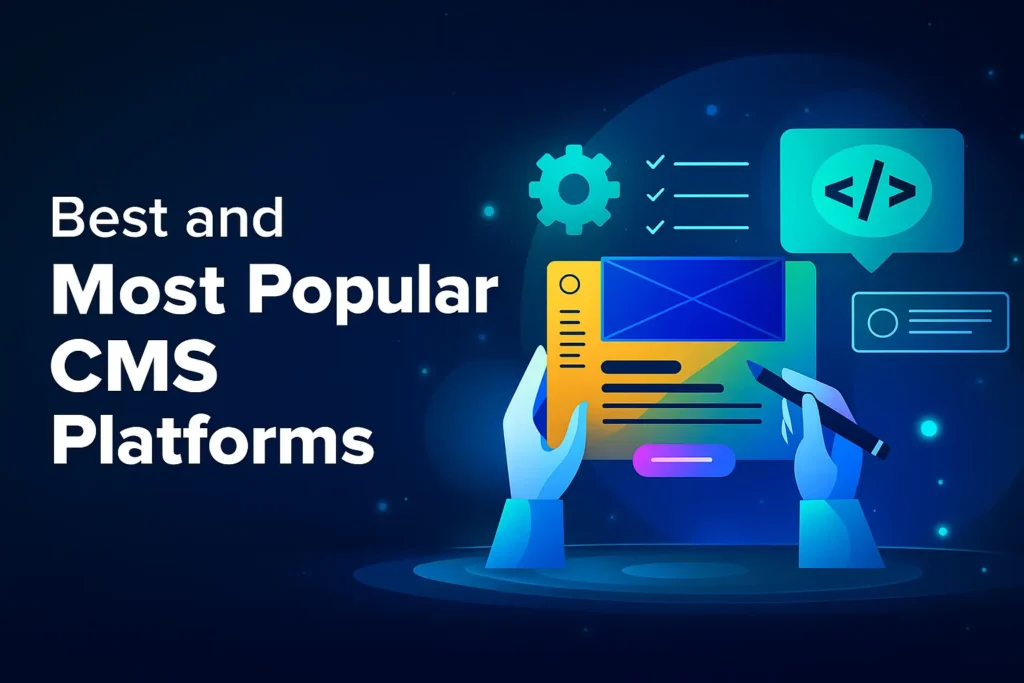A few months ago, I was helping a smallhealth startup move their old blog into modern publishing technology. What seemed like it would be an easy assignment turned out to be one of the messiest digital puzzles I’d encountered in years. Their prior CMS was based on legacy plugins. Images were broken. Their URL structure looked like it was held together with duct tape.
That night, I opened five different CMS platforms side by side and tested each one with the exact same dataset.
I wanted clarity. I needed speed. And, honestly, I wanted to avoid future trauma.
That experiment changed how I think about CMS platforms forever. Some tools surprised me in ways I didn’t expect. Others looked perfect at first glance but fell apart once I dug deeper. A few even stood out as clear winners the moment I clicked around and tested their workflows.
This guide is the result of those real tests, experiences, migrations, headaches, wins, and discoveries.
Not generic information. Real insights from someone who has been inside these systems, cleaned up their messes, and enjoyed their superpowers.
What Makes a CMS Platform Truly Great?
Before diving into the fifteen platforms, here are the criteria I used during testing:
- Speed in real publishing workflows
- Stability when dealing with large content libraries
- Plugin ecosystem maturity
- Security handling
- SEO flexibility
- Editor experience
- Hosting and infrastructure peace of mind
- Actual problems solved (not marketing fluff)
When I talk about CMS speed, hosting becomes a huge factor. If someone is using WordPress or any self hosted CMS, their experience depends massively on their server. This is where choosing the right beginner friendly hosting provider matters a lot and I’ve already covered a few solid options in my guide here: Best Web Host for Beginners.
The 15 Best CMS Platforms (Expert Tested and Compared)
Below are the platforms in no particular order. Each shines for a different reason.
1. WordPress: The CMS I’ve Loved, Fought With, And Still Recommend
I’ve built dozens of websites on WordPress. Blogs. Stores. Portfolio sites. SaaS landing pages.
Here’s the truth:
WordPress is unbeatable for flexibility but chaotic if you don’t know what you’re doing.
Real Experience Highlights
- I once restored a broken WordPress site in 45 minutes using backups.
- I also once spent five hours debugging a plugin conflict that broke the editor.
- SEO performance is excellent when configured correctly.
- Hosting makes or breaks your experience.
Best For
Bloggers, businesses, online stores, content-heavy sites.
Weakness
Heavy dependency on plugins.
If you are starting a blog read this full guide on Best AI Tools for Bloggers. Best for research and SEO.
2. Webflow: The CMS For Designers Who Want Control Without Coding
My first Webflow project took one weekend to learn and one hour to fall in love with.
What surprised me
- CSS-like visual controls make it incredibly precise.
- The CMS Collections system feels cleaner than WordPress taxonomies.
- Hosting is fast and secure without maintenance.
Not ideal for
Teams with heavy custom backend needs.
3. Shopify CMS: More Than Just eCommerce
People ignore that Shopify has a powerful CMS for blogs, landing pages, product education, and resource hubs. If your main goal is ecommerce and you’re trying to decide between full flexibility and simplicity, Shopify and WordPress always end up being the top contenders. I’ve compared them in detail WordPress vs Shopify.
My test
I managed a 300 article import on Shopify headless, and it handled the content surprisingly well.
Weakness
The blog editor feels basic compared to standalone CMS platforms.
4. Ghost CMS: The Smoothest Writing Experience I’ve Ever Used
If speed mattered more than everything else, I’d choose Ghost.
What worked
- Publishing workflow is insanely fast.
- Built in membership and newsletters reduce external tools.
What didn’t
Integrations require Zapier or custom work.
Great for creators who want minimal distractions.
5. Joomla: The Underrated Powerhouse
People sleep on Joomla, but for structured content and role management, it beats WordPress in many cases.
My experience
Used it for a government portal. Stability was top-tier.
Weakness
Learning curve is steeper.
6. Drupal: When Enterprise-Level Security Is Priority
Drupal is not casual friendly. But when I used it for a large organization needing multi-site, multi-permission workflows, nothing else matched its robustness.
Benefits
- Bulletproof security
- Advanced workflow tools
Downside
Not a beginner friendly ecosystem.
7. Squarespace: The CMS For Fast, Beautiful, No-Nonsense Sites
A client once needed a portfolio ready in 24 hours. Squarespace delivered without stress.
Strength
Templates are unbeatable in visual polish.
Weakness
Limited extensibility beyond visual features.
8. Wix: Beginner-Friendly With Surprising Power
Wix used to be a beginner toy. Not anymore. The Wix Studio and dev tools are surprisingly capable.
Real discovery
The SEO panel is cleaner than most CMS platforms.
9. Notion As A CMS: Weird, But Brilliant For Certain Teams
For internal knowledge bases published publicly, Notion wins.
When I used it
I built a live public documentation site in 3 hours.
Limitation
Not ideal for SEO heavy content.
10. Sanity CMS: The Developer’s Playground
Sanity blew my mind with real-time content collaboration.
Experience
Integrated Sanity into a Next.js project. The flexibility was unmatched.
Best Use
Headless setups that want complete customization.
11. Strapi: The Open Source Headless CMS Developers Love
When I built a content API for a mobile app, Strapi saved me weeks.
Strength
Open-source. Fast. Customizable fields.
Weakness
Requires self hosting or paid cloud.
12. Contentful: Enterprise-Grade Without The Pain
Contentful is the cleanest headless CMS I’ve used.
What impressed me
Editor experience and API reliability.
Downside
Pricing climbs quickly for scaling teams.
13. HubSpot CMS: Ideal For Marketing-Heavy Businesses
Integrated CRM + CMS is extremely convenient.
What worked
Creating automated funnels from blog posts felt seamless.
Weakness
Less suited for developers wanting control.
14. Adobe Experience Manager: The Corporate Giant
Most complicated, most powerful, most expensive.
Used it once
For a banking client with multilingual, multi-brand needs.
A beast, but unbeatable in its league.
15. Blogger: Old, Simple, But Still Reliable
I still meet beginners who start here. Simple, stable, and free.
Weakness
Severely limited for long-term scaling.
Detailed CMS Platforms Comparison
| CMS Platform | Best For | Strength | Weakness |
|---|---|---|---|
| WordPress | Everything | Plugins, flexibility | Plugin dependency |
| Webflow | Designers | Visual precision | Limited backend |
| Shopify | Ecommerce | Stable and scalable | Basic blog editor |
| Ghost | Creators | Fast, clean writing | Integration limits |
| Drupal | Enterprise | Security | Hard learning |
| Strapi | Developers | Fully customizable | Self hosting |
| Contentful | Enterprise | API performance | Pricing |
| Squarespace | Portfolios | Polished designs | Limited customizations |
According to a usability report by Nielsen Norman Group, ease-of-use and responsiveness are critical for retaining visitors and building trust — a strong argument for choosing a CMS and hosting setup that prioritize speed and smooth user experience.
Final Thoughts: Choosing A CMS Platform Should Match Your Real Workflow
Upon testing dozens on real client sites now, I’ve come to realise that the perfect CMS just doesn’t exist. Each platform excels in an area and falters in another. What really counts is how well the system fits your workflow, publishing volume, and habits that will become institutional memory for years to come.
If you want ultimate flexibility and endless customization, WordPress is still the way to go. When I need absolute control over design versus plugins or backend, Webflow is what I use. For writers who don’t want anything distracting their thought process, it doesn’t get much better than what Ghost offers. And on projects with complex structure, enterprise workflow or headless architecture involved, tools like Drupal and Sanity can often save entire teams months of technical headaches down the line.
The real object is to select a CMS that reduces friction rather than increasing it. At the end of the day, your perfect CMS is one where publishing feels comfortable, quick, and consistent regardless of how huge your content gets.
You can subscribe our Newsletter for latest tech guides.
FAQs — What CMS Platforms Are People Asking Questions For?
So which is the best CMS right now?
Those would be honest answers, depending on what you’re building. For the vast majority of sites, I still use WordPress – It’s got a lot of flexibility, very fast to tack up and have never (or at least extremely rarely) hit limits. But you’re building an online store, Shopify is almost always the better choice.
What is the easiest CMS for beginners?
Use Wix or Squarespace if you don’t know much about code. I have personally helped a handful of clients launch their first sites on Wix — and editing pages just minutes after going live. It’s simple and beginner-friendly.
Is WordPress worth learning in 2025?
Yes, absolutely. Some of the newer CMS’s have wit and pizzazz, but WordPress is still the most dependable one I’ve used. The plugin ecosystem continues to get better, and optimization is far easier than most of the tools I’ve tried.
Which CMS is best for ecommerce?
As I’ve found, ecommerce is Shopify’s wheelhouse — it just works. You’re able to do payments, shipping and products with no need to write code. If you’re already using WordPress, they’re a great choice.
What’s a “headless CMS” that everyone keeps talking about?
A headless CMS is essentially taking your content away from the design of your website. Developers love that it can let you push the same content to apps, websites or even smart devices. I’ve worked on a few projects using Strapi and Contentful (they are great if you have a dev) squad.
Which CMS is best for business websites?
For small or midsize businesses, WordPress still takes the prize: It’s inexpensive to set up and simple enough even for nontechies to use. If you’re running a large company that has serious security requirements, consider Drupal or HubSpot CMS. They’re both more stable for large-scale, enterprise-level projects.
Which CMS is better for SEO?
In my experience, WordPress and Webflow perform best for SEO. You get full control over titles, meta tags, and schema. I’ve ranked pages quickly using both, especially when paired with clean hosting.
Are there CMS platforms with built-in AI tools?
Yes, quite a few now. HubSpot, Webflow, and Contentful have added AI features that help write or optimize content. It’s not perfect, but it saves a lot of time — especially for drafts or image descriptions.


